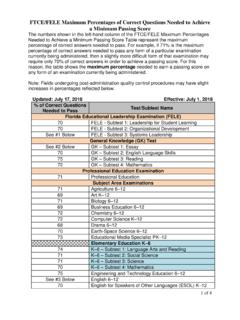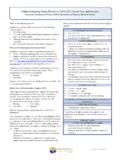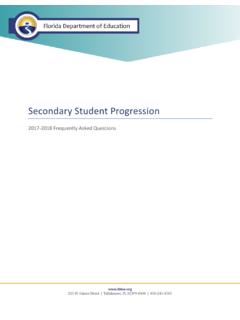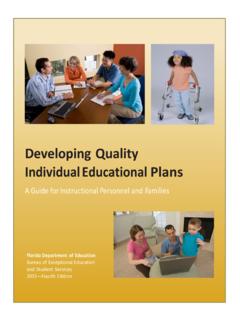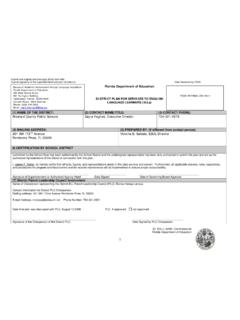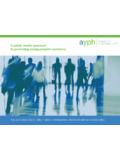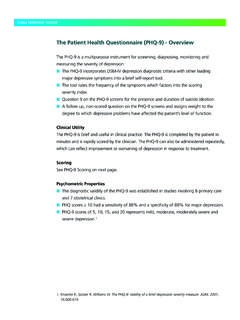Transcription of Secondary Comprehensive Health Education Toolkit
1 Florida Department of Education Comprehensive Health Education Secondary Toolkit The Comprehensive Health Education Secondary Toolkit will assist classroom teachers, school nurses and others who are responsible for the delivery of Health Education . The Toolkit is an electronic resource for the essentials of Health Education instruction. Each section highlights the component area and provides a litany of tools, websites, lessons and a variety of information. This document is available at the FDOE Comprehensive Health Education webpage. Health Education is integral to the primary mission of schools. It provides students with a continuum of learning experiences to develop the knowledge and skills necessary to become successful learners and Health literate adults. Health literacy is a fundamental part of the school Health Education program and is essential to the Health and wellness of each student.
2 Health Education provides students with the knowledge and skills they need to be healthy throughout their lifetime. The intent of a Comprehensive Health Education program is to motivate students to maintain and improve their social, emotional and physical Health , prevent disease and avoid or reduce Health related risk behaviors. Comprehensive Health Education addresses 12 required component areas for K-12 instruction under section (2)(n), Florida Statutes. Teen dating violence is only required in grades 7 - 12. 1. Community Health 2. Consumer Health 3. Environmental Health 4. Family life 5. Injury prevention and safety 6. Internet safety 7. Mental and emotional Health 8. Nutrition 9. Personal Health 10. Prevention and control of disease 11. Substance use and abuse 12. Teen dating violence The required concepts may be offered in a traditional Health Education course. However, low enrollment prompted the integration of Health Education benchmarks in 2012, where appropriate.
3 These integrated benchmarks can be found in other content areas courses such as English language arts, fine arts, JROTC, peer counseling, physical Education , science and social studies. The Florida Department of Education 's (FDOE) Course Directory is a great resource for locating the current course listings. The CPALMS website is the best resource for the current standards, Bureau of Standards and Instructional Support Healthy Schools Florida Department of Education Comprehensive Health Education Secondary Toolkit benchmarks and course descriptions. Health Education Description Educator Resources Component Area 1. CDC Healthy Living 2. Coping With Stress 3. Drug and Alcohol Use on School Property Among Florida Public Focuses on individual responsibility; healthy work, school and community High School Students environments; community Health resources and facilities; community 4. Every Kid Healthy Week and state agencies; Health service careers; safety hazards; community 5.
4 FDOE Child Human Trafficking Tool Chapter laws and policies related to Health issues; data and trends regarding 6. FDOE Gang Resources for Parents and Teachers Health issues; social marketing and norming; emergency/crisis response 7. FDOE Healthy Schools Community Health plans; community involvement; current issues; trends in medical care; 8. FDOE Safe Schools community Health planning; private resources (hospitals, clinics and 9. Five Minutes (or Less) for Health insurance companies); and volunteer resources and organizations ( 10. HEADS UP to Youth Sports: Officials Fact Sheet American Red Cross, American Cancer Society). 11. Health & Academics 12. Healthy Meeting Toolkit 13. Helping Children and Adolescents Cope with Violence and Disasters: What Community Members Can Do 14. Let's Go! Healthy Workplaces Toolkit 15. Obesity Resource Toolkit for Healthcare Providers Bureau of Standards and Instructional Support Healthy Schools Florida Department of Education Comprehensive Health Education Secondary Toolkit 16.
5 Overcoming Harmful Cultural Norms 17. Parent Engagement Fact Sheets 18. Physical Activity Among Florida Public High School Students 19. Poison Prevention Community Health 20. Poison Prevention Week Posters (continued). 21. School Health Index (SHI). 22. School Wellness Toolkit 23. Safe Routes to School Planning Toolkit 24. Safe Routes to School 25. Sexual Behaviors Among Florida Public High School Students 1. CDC Food Safety 2. CDC Healthy Schools Focuses on being wise consumers of Health information, products and 3. CDC Healthy Living services, including understanding the influences of advertising, media 4. Connecting Youth to Quality Health Information and technology; being able to evaluate and make selection and 5. Consumer Health Education purchasing decisions about Health -related products and medical services; 6. Consumer Reports Health Information, Products & Services Consumer Health consumer protection laws (product labeling); consumer protection 7.
6 FDOA Food Inspections agencies; Health agencies and organizations; Health insurance; quackery; 8. FDOA Food Safety reliable Health products and services; and knowing what is available and 9. FDOA Living Healthy in Florida how to be an educated consumer. 10. FDOE Healthy Schools 11. Food Allergy Research & Education (FARE): Resources for Schools 12. Health & Academics Bureau of Standards and Instructional Support Healthy Schools Florida Department of Education Comprehensive Health Education Secondary Toolkit 13. Health Communication and Social Marketing 14. Health Literacy 15. Food and Drug Administration Focuses on causes, prevention and control of environmental pollution, 1. CDC Healthy Living including air, water, soil, radiation, noise and solid waste (recycle, reuse 2. e-Learning on Environmental Assessment of Foodborne Illness and reduce); effects of environment on Health (includes understanding Outbreaks Environmental Health the causes of negative environmental factors and their effects on human 3.)
7 EPA Healthy Schools, Healthy Kids Health ); environmental protection agencies; population growth; 4. Hurricane Readiness worldwide Health ; and individual and group responsibilities in helping to 5. Physical Environment promote a healthy environment locally and worldwide. 6. United States Environmental Protection Agency (EPA). 1. Be Yourself/S t mismo: Positive Youth Development for Latino Teens (Video). 2. Building Community Commitment for Safe, Stable, Nurturing Relationships and Environments Focuses on family structures, roles and responsibilities; gender roles; 3. CDC Asthma Awareness Podcast sexual stereotypes; marriage; divorce; human sexuality Education ; 4. CDC Eat Well Podcast abstinence; parenting; physical and sexual abuse; building family 5. Child Abuse Prevention Family Life relationships; child abuse and neglect; the family life cycle; family 6. Coping With Stress planning; heredity; and communication skills (verbal, nonverbal and 7.
8 Concussions HEADS UP to Schools: Parents- English or Spanish listening). 8. Essentials for Childhood 9. FDOA Summer Food Service Program 10. FDOE Child Human Trafficking Tool Chapter 12. FDOE Healthy Schools- Comprehensive Health Education Bureau of Standards and Instructional Support Healthy Schools Florida Department of Education Comprehensive Health Education Secondary Toolkit 13. FDOE Just For Parents Community 14. FDOE Just For Parents Newsletters 15. Family Health History 16. Family Memoir: Getting Acquainted With Generations Before Us 17. Health & Academics 18. Intimate Partner Violence 19. Genomics and Health : Heart Disease and Family History 20. PARC: Pregnancy Prevention for Adolescents and Expectant &. Parenting Teens (Video). 21. Parent Engagement Fact Sheets 22. Parents, Families and Friends of Lesbians and Gays (PFLAG). Family Life 23. Parents for Healthy Kids (continued) 24.
9 Positive Parenting Practices Fact Sheets 25. Project AIM: Teen Pregnancy Prevention and Positive Youth Development for Rural Youth (Video). 26. Promoting Health Among Teens: Abstinence-Only Intervention for Urban Youth (Video). 27. Promoting Parent Engagement in Schools to Prevent HIV and other STDs Among Teens 28. NetSmartz Workshop Sexting 29. School Connectedness Fact Sheets 30. Sexual Risk Behaviors: HIV, STD, & Teen Pregnancy Prevention 31. Suicide: A Major, Preventable Mental Health Problem 32. Teen Pregnancy Prevention Program Bureau of Standards and Instructional Support Healthy Schools Florida Department of Education Comprehensive Health Education Secondary Toolkit 33. The Dangers Of Social Media (Child Predator Social Experiment). 34. The Office of Adolescent Health (OAH). 35. Tips for discussing difficult topics with your children 36. Underage Drinking 1. Be Safe in the Sun 2.
10 CDC Restrain Yourself Podcast Focuses on attitudes toward safety; causes of accidents; home and 3. CDC Healthy Living school safely; highway safety, including pedestrian, auto, bicycle, 4. CPALMS Lesson Plan Heart Rate Activity: Body Positions and recreation vehicle and school bus; natural and weather related disasters; Physical Activity safety practices that reduce risks of unintentional injuries ( , fire, bike, 5. Concussion ABCs: HEADS UP to Schools Injury home, weapon and babysitting safety); survival skills; environmental 6. FDA Sun Safety Prevention/Safety hazards; personal safety precautions, including assault and child abuse 7. FDOE Healthy Schools- Comprehensive Health Education and neglect prevention; violence prevention; bullying prevention; 8. FDOT Alert Today Alive Tomorrow internet safety; dating violence; first aid/CPR/AED and emergency Health 9. FDOT Florida's Pedestrian and Bicycle Focused Initiative care procedures to follow in case of an injury, Health problem, disaster or 10.
